AMD's Radeon HD 4870 X2 - Testing the Multi-GPU Waters
by Anand Lal Shimpi & Derek Wilson on August 12, 2008 12:00 AM EST- Posted in
- GPUs
General Performance at 2560x1600
We've already established that in games with CrossFire support, the Radeon HD 4870 X2 is the grand poobah of gaming performance. Along with such a title comes a general requirement: if you're dropping over $500 on a graphics card on a somewhat regular basis, you had better have a good monitor - one of many 30" displays comes to mind. Without a monitor that can handle 2560x1600, especially with 2x 4870 X2 cards in CrossFire, all that hard earned money spent on graphics hardware is just wasted.
Since the target resolution here is 2560 x 1600, let's see how the 4870 X2 stacks up in our suite of games at this resolution:
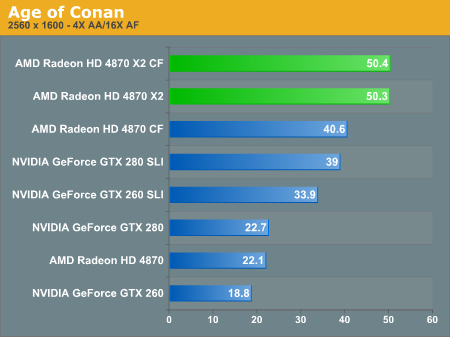
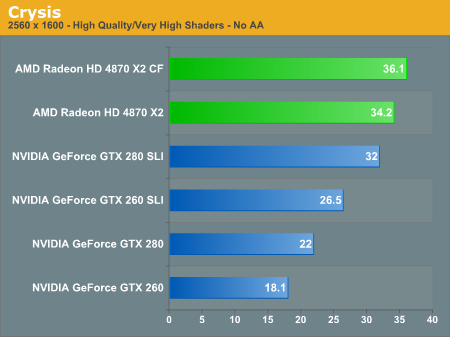
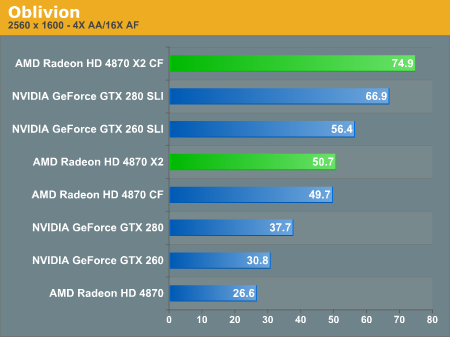
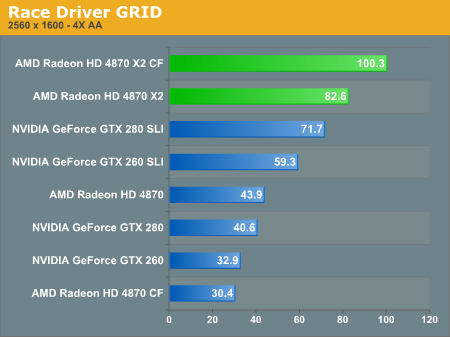
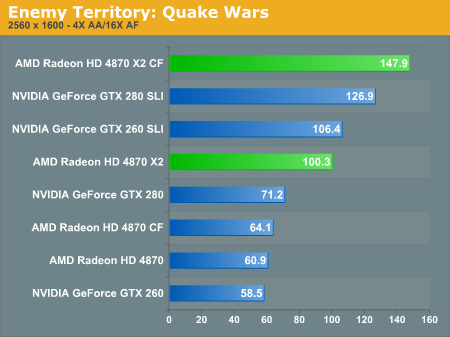
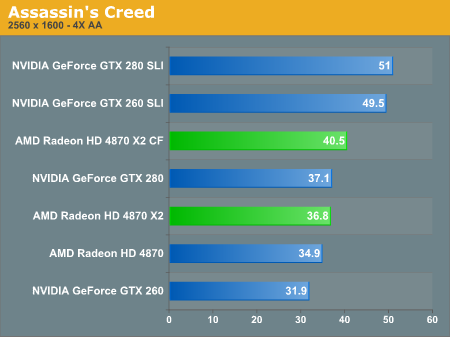
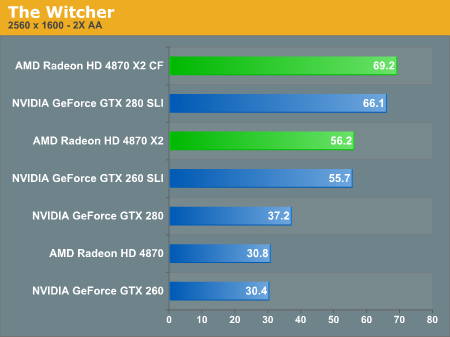
The 4870 X2 holds its own against its major competition from NVIDIA, the GTX 260 SLI, in 4 of our 7 benchmarks, while the 4870 X2 CrossFire leads the pack in all but one game (Assassin's Creed). It is always tough to pick the games we want to test, as the games we pick end up deciding what we think of performance. We try to pick games that are both interesting to the community and/or show interesting performance differences between hardware. In this case, what we have here is a pretty good picture of the general case: the 4870 X2 and GTX 260 SLI are pretty well matched.
Of course, the GTX 260 SLI option is two cards which requires an NVIDIA motherboard. This puts it at a bit of a disadvantage to a single card solution that is platform agnostic. And we also have the fact that at the target resolution of 4870 X2 CrossFire AMD does have the most powerful option that fits into two slots. These are very important factors for AMD, but as we've seen before 4-way solutions aren't the value option (you don't get the same return on your money as you might with other solutions even if you do get high performance).
Taking into account the price drops, we also see the single GPU arena looking very competitive with the GTX 260 and HD 4870 about on par. In these tests, the HD 4870 looks to have an advantage, but again we could add a few more benchmarks and see the GTX 260 do better. This is what we like to see: real competition. Of course, the tough question to answer here is whether or not the GTX 280 is worth 1.5x either the GTX 260 or the 4870.










93 Comments
View All Comments
Spoelie - Tuesday, August 12, 2008 - link
How come 3dfx was able to have a transparant multigpu solution back in the 90's - granted, memory still was not shared - when it seems impossible for everyone else these days.Shader functionality problems? Too much integration (a single card voodoo2 was a 3 chip solution to begin with)?
Calin - Tuesday, August 12, 2008 - link
The SLI from 3dfx used scan line interleaving (or Scan Line Interleaving to be exact). The new SLI still has Scan Line Interleaving, amongst other modes.The reason 3dfx was able to use this is that the graphic library used was their own, and it was built specifically to the task. Now, Microsoft's DirectX is not built for this SLI thing, and it shows (see the CrossFire profiles, selected for the best performance for a game, depending on that game).
Also, 3dfx's SLI had a dongle feeding video signal from the second card (slave) into the first card (master), and the video from the two cards was interleaved. Now, this uses lots of bandwidth, and I don't think DirectX is able to generate scenes in "only even/odd lines", and much of the geometry work must be done by both cards (so if your game engine is geometry bound, SLI doesn't help you)
mlambert890 - Friday, August 15, 2008 - link
Great post... Odd that people seem to remember 3DFX and dont remember GLIDE or how it worked. Im guessing they're too young to have actually owned the original 3D cards (I still have my dedicated 12MB Voodoo cards in a closet), and they just hear something on the web about how "great" 3DFX was.It was a different era and there was no real unified 3D API. Back then we used to argue about OpenGL vs GLIDE and the same types of malcontents would rant and rave about how "evil" MSFT was for daring to think to create DirectX
Today a new generation of illinformed malcontents continue to rant and rave about Direct3D and slam NVidia for "screwing up" 3DFX when the reality is that time moves on and NVidia used the IP from 3DFX that made sense to use (OBVIOUSLY - sometimes the people spending hundreds of millions and billions have SOME clue what they're buying/doing and actually have CS PhDs rather than just "forum posting cred")
Zoomer - Wednesday, August 13, 2008 - link
Ah, I remember wanting to get a Voodoo5 5000, but ultimately decided on the Radeon 32MB DDR instead.Yes, 32MB DDR framebuffer!
JarredWalton - Tuesday, August 12, 2008 - link
Actually, current SLI stands for "Scalable Link Interface" and has nothing to do with the original SLI other than the name. Note also that 3dfx didn't support anti-aliasing with SLI, and they had issues going beyond the Voodoo2... which is why they're gone.CyberHawk - Tuesday, August 12, 2008 - link
nVidia bought them .... and is now uncapable of take advantage if the technology :DStevoLincolnite - Tuesday, August 12, 2008 - link
They could have at least included support for 3DFX glide so all those GLIDE only games would continue to function.Also, ATI have had a "Dual GPU" Card for many years (Rage Furry Maxx) before nVidia released one.
TonyB - Tuesday, August 12, 2008 - link
can it play Crysis though?two of my friends computer died while playing it.
Spoelie - Tuesday, August 12, 2008 - link
no it can't, the crysis benchmarks are just made upstop with the bearded comments already
MamiyaOtaru - Wednesday, August 13, 2008 - link
Dude was joking. And it was funny.It's apparently pretty dangerous to joke around here. Two of my friends died from it.